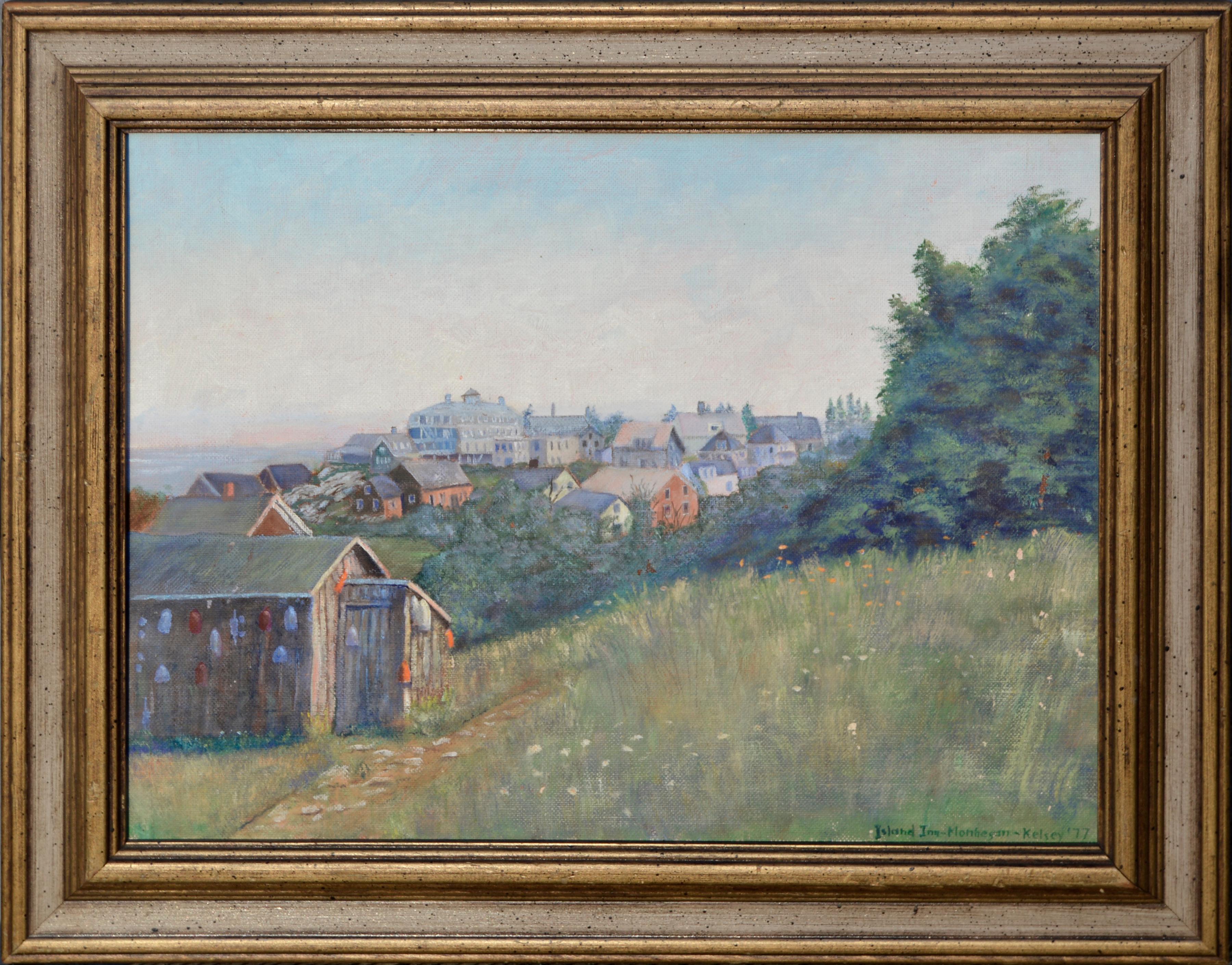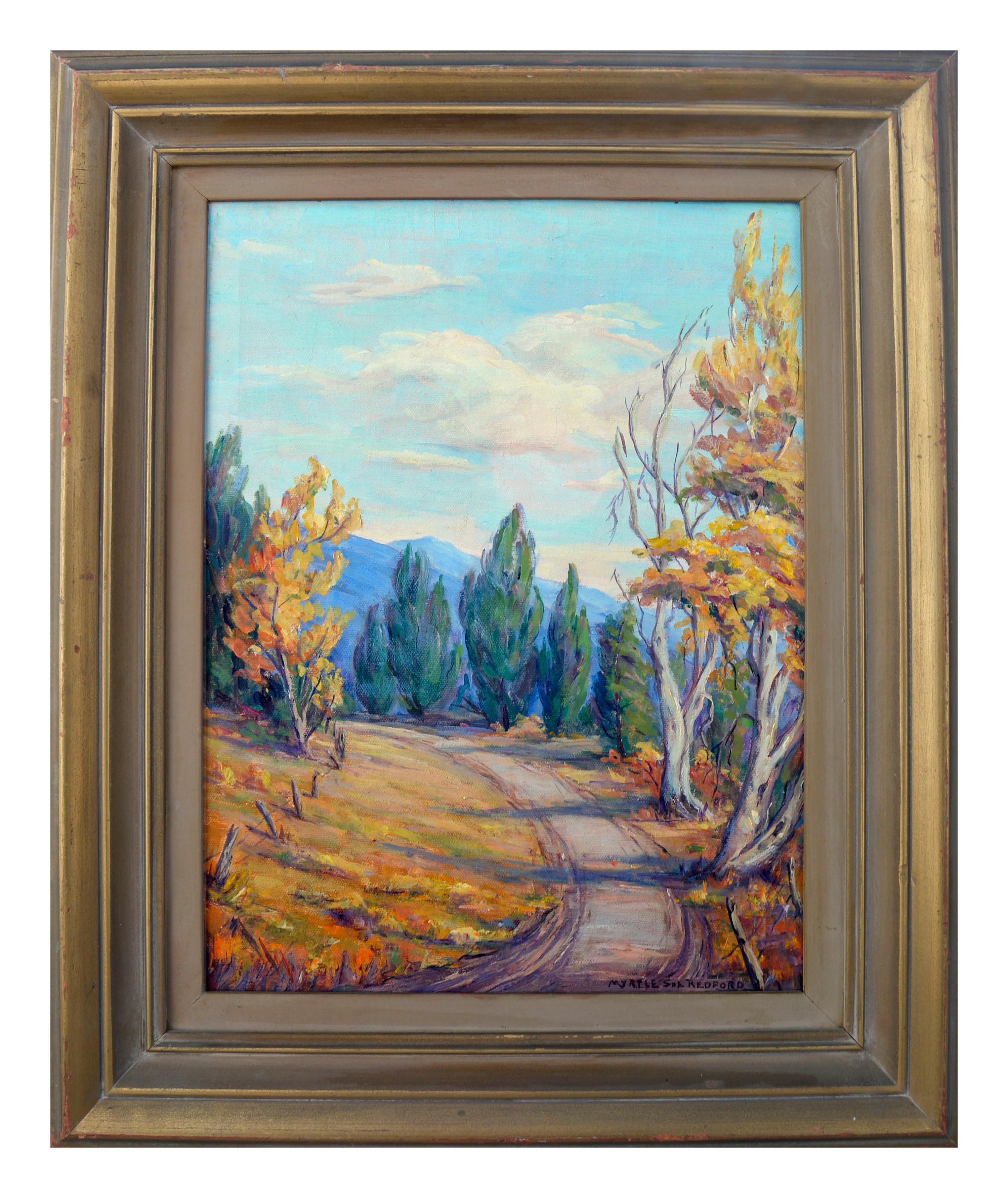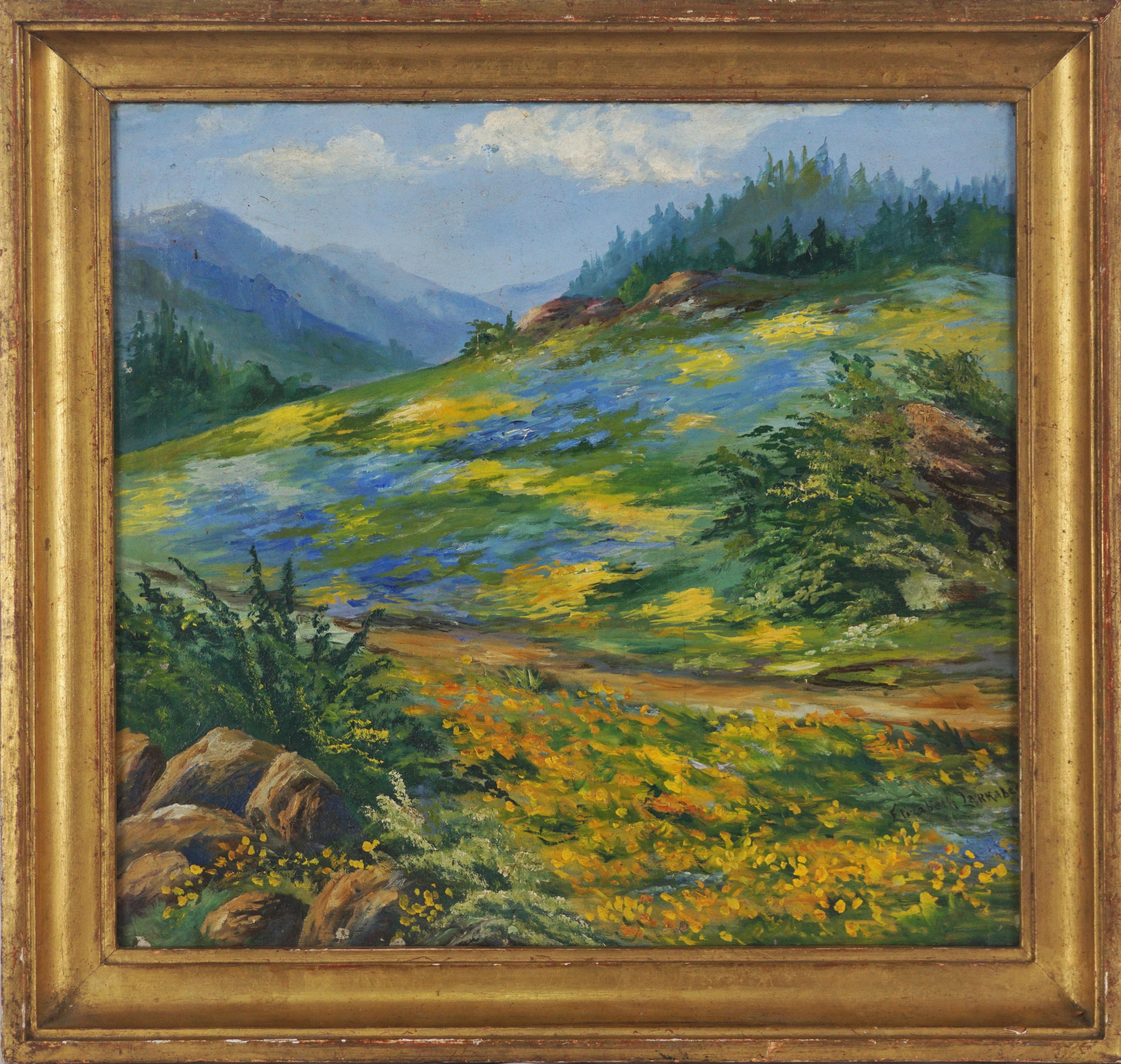Items Similar to "View of New York Harbor, Staten Island Ferry, " Gustave Wolff, Impressionism
Want more images or videos?
Request additional images or videos from the seller
1 of 8
Gustave Wolff"View of New York Harbor, Staten Island Ferry, " Gustave Wolff, Impressionism
About the Item
Gustav (Gustave) Wolff (1863 - 1935)
View of New York Harbor from the Staten Island Ferry
Oil on canvas
16 x 12 inches
Signed lower right
In the Autumn of 1913, the German Association for Culture featured the work of Gustave Wolff (1863- 1935) in one of the artist's first New York City exhibitions held at the Yorkville Library. The New York Times stated, "Mr. Wolff is better known in the West and in Europe than in New York, and this is the first opportunity to see a collection of his work in this city."
A painter of Impressionist and Tonalist landscapes, Wolff arrived in New York most likely within the year prior to this exhibition. However, by the 1910's, the American art scene was witnessing a shift toward modernism. American Impressionism, which began as a rebellion against conservative academic artistic standards, was now endorsed by the National Academy of Design, while urban realism and abstraction became the new form of artistic protest. Having matured artistically around the turn of the century, just before this major shift, Gustave Wolff remained committed throughout his career to capturing the everyday poetry of the rural and urban landscape.
Raised in St. Louis after his family immigrated to the United States in 1866 from Berlin, Germany, Wolff studied at the St. Louis School of Fine Arts and with Paul Cornoyer, F. Humphrey Woolrych, and Frederick Oakes Sylvester. By 1901, Wolff had become the preeminent painter in St. Louis and a frequent exhibitor with the St. Louis Artists' Guild, the Society of Western Artists, and the Two-By-Four Club, leading one critic to write:
"If the maxim that artists are born, not made, be true, it applies most decidedly to Mr. Wolf [sic], whose training was as unsystematic and interrupted as his career was subjected to influences most unfavorable to his artistic development. But in spite of all difficulties he has forged his way to the front until his work has become of such importance that an exhibit of Western Artists would be incomplete without his admirable landscapes."
By 1906, Wolff was considered one of the leading landscape painters in St. Louis. It was in that year that two of his paintings were accepted to the Paris Salon. One humorous and rather cynical article discussed Wolff's success:
"Gustav[sic]Wolff of St.Louis,who does the fine art decoration of the billboards behind which you threw the tin cans this spring, has just had a bit of luck . . . [T]he people who sniffed when they saw Mr. Wolff sitting under a screen and daubing the billboards are surprised to learn that two pictures of his have now been accepted by and are hung conspicuously in the Paris salon. He is known in Paris as a landscape painter of ability and exquisite workmanship."
Like many American painters in this period, Wolff traveled to the Netherlands for further artistic training. In the late nineteenth century, there was a growing fascination in the United States with Dutch Art of the seventeenth-century, which became widely collected. At the same time, more affordable works by contemporary Dutch artists working in The Hague were increasingly collected especially by patrons in St. Louis.
Guided by Dutch Old Master depictions and romanticized literary descriptions, American artists visiting the Netherlands produced images of domesticity, strong communities, and religious values. Having trained in St. Louis, where Dutch artistic influence was strong, Wolff had already adopted the loose, confident brush- work and atmospheric effects that characterize Dutch painting.
When Wolff arrived in New York City in the early 1910s, he would have encountered the group of urban realist painters who dominated the New York art scene. The Eight, or the artists of the Ashcan School, were known for their frank, un-idealized depictions of common people and the industrial energy of New York. Their works presented the appealing, yet gritty reality of this urban environment and the transitory nature of the city. Wolff's paintings of everyday life often depict scenes of leisure, typical of the Impressionist manner. However, expressing the character of the modern metropolis was also a significant statement of his work.
Wolff's light-filled images such as Washington Heights Bridge, New York; and Approaching the Wheelock Mansion, West 160th Street, New York express the joy of leisure and relaxation that was sought amid the density and grittiness of New York. Like the paintings of American Impressionist William Merritt Chase, who had spent the early 1870's active in the St. Louis art scene, and who was considered one of the most important artists and teachers in New York by the turn of the century, Wolff's scenes of urban leisure are populated by New York's fashionable elite.
Approaching the Wheelock Mansion, West 160th Street, New York depicts well dressed New Yorkers walking along a path that cuts neatly through a field, the lushness of which is enhanced by Wolff's loose and rapid application of vibrant tones of green. Wheelock Mansion was built in the 1860's in Audubon Park by William A. Wheelock and remained an important monument to Victorian style architecture amid the rapidly changing city until its demolition in 1939. Wolff's meditation on this fleeting moment of urban life and the anonymity of the figures on the path can easily be compared to the Ashcan artists' illustration of interactions between strangers in New York's public spaces.
In contrast to his scenes of leisure, Wolff also produced paintings of New York's commercial activity. Typical of the Impressionist mode, A Winter Day, 79th Street Boat Basin, New York displays Wolff's mastery of color and light effects in the lavender and orange clouds juxtaposed against the crisp blue sky, and the rippled shadows of the boats on the water.
Wolff's confidence and control is revealed in the sweeping brush- strokes of the water and the rough texture of the sky, demonstrating the influence of artists like Chase and John Singer Sargent. His grittier scenes reveal the industrial activity along the shores of New York. In Harlem River Factories, New York, Wolff balances the flourish of Impressionist brushstrokes in the bright white clouds with the browns and grays of the murky water. The artist has noticeably omitted any figures from this image, instead focusing on the stark beauty of this commercial waterfront. A decade after his arrival in New York, Wolff continued to exhibit his river and harbor scenes to favorable reception from the press.
- Creator:Gustave Wolff (1863 - 1935, American)
- Dimensions:Height: 22 in (55.88 cm)Width: 18 in (45.72 cm)
- Medium:
- Movement & Style:
- Period:
- Condition:
- Gallery Location:New York, NY
- Reference Number:1stDibs: LU1841210505942
About the Seller
5.0
Platinum Seller
These expertly vetted sellers are 1stDibs' most experienced sellers and are rated highest by our customers.
Established in 2021
1stDibs seller since 2022
63 sales on 1stDibs
Typical response time: <1 hour
- ShippingRetrieving quote...Ships From: Larchmont, NY
- Return PolicyA return for this item may be initiated within 3 days of delivery.
More From This SellerView All
- "The Green Parasol, " Henry Hannig, American Impressionist, Woman in Beach SceneBy Henry HannigLocated in New York, NYHenry Charles Hannig (1883 - 1948) The Green Parasol Oil on canvas mounted on board 6 x 7 3/4 inches Provenance: R.H. Love Galleries, Chicago, Illinois Private Collection, Lake Orion, Michigan Hannig, born in Hirschberg, Germany on 27 February 1883, came to America with his parents at the age of seven. He attended school in the southwest suburbs before the family settled in Chicago. Young Henry enrolled in the Chicago Academy of Fine Arts where Lawton Parker became his mentor. He made ends meet by working in industrial design and illustration. By 1908 he was a pupil in the School of the Art Institute of Chicago where students followed the traditional European drawing curriculum, beginning with the copying of master engravings and drawing after plaster casts, then concentrating on the nude figure. Students worked toward the goal of winning various academic prizes. One of Hannig's fellow students was Louis Ritman...Category
1910s American Impressionist Figurative Paintings
MaterialsCanvas, Oil, Board
- "Wellfleet, Cape Cod, " Gerrit Beneker, American Impressionism, ProvincetownBy Gerrit BenekerLocated in New York, NYGerrit Beneker (1882 - 1934) Wellfleet, Cape Cod, Massachusetts, New England, 1926 Oil on canvas 20 x 16 inches Signed, titled, and dated lower left Provenance: Louis H. Barnett, Fort Worth, Texas In 1905, Gerrit Beneker began his art career as an illustrator. He married Flora Judd, his high school sweetheart from Grand Rapids and they moved to Brooklyn, NY. Gerrit's early passion was to create an art that would inspire and provide honor to the workingman. As such, he had no interest in painting portraits of pretty women, which were so often seen on the magazine covers of the day. Rather he wanted to seek out workingmen on the bridges, tunnels and skyscrapers of NYC, and paint them in their environments. He completed over 150 magazine covers, numerous ads including many for Ivory Soap...Category
1920s American Impressionist Landscape Paintings
MaterialsOil, Canvas
- "Winter Scene: Canal Near New Hope, Pennsylvania" Impressionist Snowy LandscapeBy George Gardner SymonsLocated in New York, NYGeorge Gardner Symons Winter Scene: Canal Near New Hope, Pennsylvania Signed lower left Oil on canvas 30 x 38 inches Provenance: Galleries Maurice Sternberg, Chicago, Illinois Private Collection Sotheby Parke Bernet, New York, American 19th & 20th Century Paintings, 1976, Lot 121 Christie's New York, American Art, June 5, 1997, Lot 66 The Honorable Serena Perretti, Short Hills, New Jersey (acquired directly from the above) Estate of the above, 2023 A landscape and marine artist, George Symons was one of America's more noted plein-air painters who combined styles of impressionism and realism. His works are cited for their energy and simplicity, and he often did panoramic views. He was born in Chicago, Illinois in 1861, with the name of George Gardner Simon, but he changed his last name to Symons when he returned from study in England because of concern about anti-semitism. Not much is known about his early life. He first studied at the Chicago Art Institute where he became a close, life-long friend of William Wendt. They painted together in California and then in Cornwall, England in 1898. He also studied in Paris, and Munich and London, and joining a colony of artists at St. Ives, adopted the plein-air techniques of Julius Olsson, Adrian Stokes, and Rudolph Hellwag. He worked in Chicago as a commercial artist, and about 1903 returned to California with Wendt and built a studio in Laguna Beach and became active in western art societies including the California Art Club. He returned often, but maintained his primary studio in Brooklyn, New York, and also did a lot of painting in Colerain, Massachusetts. Among the collections where his work can be found is the Brooklyn Institute of Arts and Sciences; the Art Institute of Chicago, and the Fleischer Museum in Scottsdale, Arizona. Associations he was a member of include the National Academy of Design, the National Arts Club, the Institute of Arts and Letters, the Lotos, Century, and Salmagundi Clubs. He was also a member of the Royal Society of British Artists and the Union Internationale des Beaux Arts et des Lettres. He painted entirely out-of-doors, frequently working in Arizona, doing desert landscape and the Grand Canyon views, which "were well received", but he is best known for his New England snow scenes, especially of the Berkshire Mountains...Category
Early 20th Century American Impressionist Landscape Paintings
MaterialsOil, Canvas
- "Milkweeds in Maine" Anne Carleton, Female American Impressionist LandscapeBy Anne CarletonLocated in New York, NYAnne Carleton Milkweeds in Maine Signed lower right Oil on canvas 37 x 48 1/2 inches ANNE CARLETON was born in Atkinson, New Hampshire in 1878 and was educated at the Mass Normal Ar...Category
Mid-20th Century American Impressionist Landscape Paintings
MaterialsOil, Canvas
- "Reflections, " Alexander Bower, Boats on the Water, American Impressionism ViewBy Alexander BowerLocated in New York, NYAlexander Bower (1875 - 1952) Reflections, Motif No. 1, Rockport, Massachusetts Oil on canvas 22 x 18 inches Signed lower right; titled on the stretcher An American Impressionist, Alexande Bower was born in New York, studied at The Pennsylvania Academy of Fine Art, and was living with his wife in Cliff Island, Maine by 1914. Despite his urban upbringing, the coast and the sea fascinated Bower. A large portion of his paintings are seascapes, particularly scenes depicting the coast of Cape Elizabeth...Category
Early 20th Century American Impressionist Landscape Paintings
MaterialsCanvas, Oil
- "Frosty Morning, " Jonas Lie, American Impressionist Winter Snow Landscape SceneBy Jonas LieLocated in New York, NYJonas Lie (1880 - 1940) Frosty Morning, Adirondacks, circa 1925 Oil on canvas 40 x 50 inches Signed lower left Provenance: Samuel and Ileen Campbell Wright ...Category
1920s American Impressionist Landscape Paintings
MaterialsCanvas, Oil
You May Also Like
- Mid Century Autumn Bay Area Mountains LandscapeLocated in Soquel, CABeautiful plein air painting of Bay Area mountains in autumn by Charles Eades (American, 1949-2009) circa 1965. Signed lower left corner "Chas. Eades." Unframed. Image 18"H x 24"W. ...Category
1960s American Impressionist Landscape Paintings
MaterialsCanvas, Oil, Cardboard
- Vintage Coastal Maine Landscape "Island Inn, Monhegan Island"By Richmond Irwin KelseyLocated in Soquel, CAThe Island Inn on Monhegan Island Maine, a beautiful landscape by Richmond Irwin Kelsey (American, 1905 - 1987), 1977. Titled "Island Inn - Monhegan", signed and dated "Kelsey '77" ...Category
1970s American Impressionist Landscape Paintings
MaterialsCanvas, Oil, Cardboard
- Mid Century High Mountain Road LandscapeLocated in Soquel, CAGorgeous California landscape titled, "The By Road" by Myrtle Sue Redford (American, 20th Century). Signed "Myrtle Sue Redford" on verso. Image, 16"H x 12"L. Myrtle Redford was a Fresno artist whose artwork won her a statewide reputation. She studied with Arthur Hill Gilbert, Abel Warshawsky and Nell Walker Warner. Myrtle was a member of the Carmel Art Association, the Santa Cruz Art League, Central California Art...Category
1950s American Impressionist Landscape Paintings
MaterialsCanvas, Oil
- Through The Spring Fields, Early 20th Century Landscape w Wildflowers in BloomLocated in Soquel, CAA gorgeous early 20th century landscape oil painting of fields of yellow and blue wildflowers in bloom by Northern Californi...Category
1920s American Impressionist Landscape Paintings
MaterialsCanvas, Oil
- Mid Century Adobe Home Near Tujunga, Southern CaliforniaBy John Anthony ConnerLocated in Soquel, CAGorgeous Southern California spring landscape of adobe home with Sycamore and Eucalyptus trees in background by John Anthony Conner (American, 1892-1...Category
1950s American Impressionist Landscape Paintings
MaterialsCanvas, Oil
- Hilltop Trail Landscape by Ken LucasBy Kenneth LucasLocated in Soquel, CAA small, winding trail invites the viewer into this beautiful verdant landscape by California artist Ken Lucas (American, 20th Century). Signed "Ken Lucas" o...Category
1990s American Impressionist Landscape Paintings
MaterialsCanvas, Oil, Illustration Board
Recently Viewed
View AllMore Ways To Browse
New York Boats
Antique St Louis
Antique New York Painting
Antique Frames New York
New Arrivers
New Arrives
Winter In New York
New York Winter
Impressionism Paris
New York Bridge Painting
New York Harbor
New York Winter Painting
Antique Boats Of America
New York Harbor Painting
20th Century Impressionism Paintings
Art New Arrivals
New York City Winter
Victorian New York





